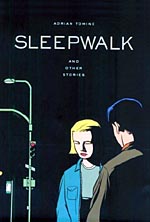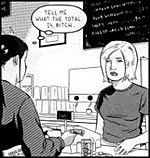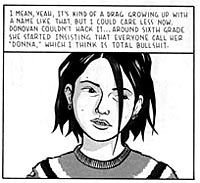
 Writer/Artist: Adrian Tomine
Writer/Artist: Adrian Tomine
Collecting OPTIC NERVE #1-4
Price: $15.95
Publisher: Drawn and Quarterly Publications
ISBN: 1896597122
"Only connect!" - EM Forster.
It's easy to judge the characters in Adrian Tomine's stories. At first glance, they seem sad, alienated, self-destructive. At first glance, his stories all seem to be about the same thing: Horrible, messed-up people who feel depressed. Thank God we're not them.
And yet it's not as simple as that.
SLEEPWALK AND OTHER STORIES is the first collection of Tomine's sporadically published OPTIC NERVE comic, which he began while still a teenager. His tales, which can run from a single page to an entire issue, chronicle moments in the lives of people ranging from a dissatisfied child to an elderly woman, who struggle to understand the world around them, or more often, themselves. Sometimes they end happily. Sometimes they don't. Sometimes, they exist only to show us a moment from a life, offered without comment or resolution.
Take the title story, about a young man named Mark. It's his birthday; he's alone. His ex-girlfriend calls him up; why not spend the night out? They go, and by the time the evening's over, Mark will have received a wake-up call about his life, that comes in a way that will jar even the most casual reader.
Or "Layover", about a man who misses a flight. He has to wait a day to catch the next plane out, so in the meantime, he heads back to town. Except everyone's already dealt with his leaving, and it seems kind of pointless to bother them again. So he wanders around, like Peter Pan locked out of the nursery, a stranger in his own life.
 Or "Summer Job", one the longer stories in the collection, in which a teenager goes to work at a second-rate Xerox place called "Kopy Shak." It's an easy job, it's not what he wants to be doing, and he holds the people who work there full-time in contempt. Does he learn to appreciate his job and his co-workers? Maybe the more important question is: Did you ever learn to appreciate the weird co-workers at your crappy summer job, or did you just use it as an excuse to waste time and get free stuff?
Or "Summer Job", one the longer stories in the collection, in which a teenager goes to work at a second-rate Xerox place called "Kopy Shak." It's an easy job, it's not what he wants to be doing, and he holds the people who work there full-time in contempt. Does he learn to appreciate his job and his co-workers? Maybe the more important question is: Did you ever learn to appreciate the weird co-workers at your crappy summer job, or did you just use it as an excuse to waste time and get free stuff?
The thing with Tomine's characters is that they're not safe. Even if you like them, bad things might happen to them. Or you can start out liking them, and then watch as they go off in a different direction from the one you would have chosen.
That's the way real life is: People make their own mistakes, and you can't live through someone else's life. Nowhere is this clearer than in the second story, "Echo Ave", where a couple engages in an act of voyeurism, then stop in a way that leaves the reader wondering what exactly they saw. As a reader, we're watching these people watch other people, and without realising it, are becoming voyeurs ourselves.
Tomine makes these vignettes more than just a Raymond Carver version of TALES FROM THE CRYPT, by giving each tale its own distinct look, tone and structure. Observe "Lunch Break", a five-page story where the first two pages take place in the present, the next two take place in a flashback, and the final page returns us to the present again.
In the present sequences, no dialogue is used, and Tomine employs a three-tiered nine-panel grid to depict the action, while in the flashback, dialogue is used and the art switches to a four-tiered eight-panel grid; in addition, the art, which consists of solid blacks and whites in the present, switches to a style including grey tones for the past. This isn't a mere gimmick; it's using the artwork to help illustrate the shift in time and space - in other words, visual storytelling.
 Looking through SLEEPWALK, it's amazing how so few of the stories look alike. Some use first-person narration, others third-person, others use no narration at all. "Supermarket" is bathed in grey tones, while "Unfaded" employs an elaborate pen-and-ink style and "Drop" is bathed in shadows, with a mere hint of white. Very few of the protagonists resemble each other physically.
Looking through SLEEPWALK, it's amazing how so few of the stories look alike. Some use first-person narration, others third-person, others use no narration at all. "Supermarket" is bathed in grey tones, while "Unfaded" employs an elaborate pen-and-ink style and "Drop" is bathed in shadows, with a mere hint of white. Very few of the protagonists resemble each other physically.
The only thing the stories in SLEEPWALK truly have in common is that they all exist in at least two worlds: The world the characters physically inhabit, and the worlds inside their minds. Either they're distanced from the people around them, or we're distanced from them and have to catch up. They're not murderers or suicides, just lonely people trying to connect to something real.
Often, they don't succeed, but sometimes the stories end on a strange note of hope: This relationship might be salvaged, or this protagonist may have learned something from his experience. In other stories, there is no judgment, good or bad. We're shown the situation, and asked to figure out what we make of it.
Are these people sick, wrong or disturbed? No more than the rest of us, really. Have you ever gone to a bar with people you didn't like because you needed to be around someone? Have you ever picked a fight you knew you couldn't win? Avoided someone from work in a social situation because it made you uncomfortable? Called up an ex because while you couldn't be with them romantically, being around them still felt like enough? Ever judged someone without getting to know them?
If you answered "yes" to any of those questions, then SLEEPWALK is for you. Sometimes, it'll make you uncomfortable. Sometimes, you'll be able to say, "That happened to me." And with some stories, you'll be uncomfortable because that happened to you.
In the end, SLEEPWALKER isn't about being sad, alienated or self-destructive - it's about being human. It's easy to think that Adrian Tomine's characters are little more than an endless parade of freaks and losers. But it's not as simple as that. The people in SLEEPWALK act the way they do not because they're insane or twisted, but because, like the rest of us, they're still trying to find a way to be part of the world around them.
They're trying to connect.

This article is Ideological Freeware. The author grants permission for its reproduction and redistribution by private individuals on condition that the author and source of the article are clearly shown, no charge is made, and the whole article is reproduced intact, including this notice.


